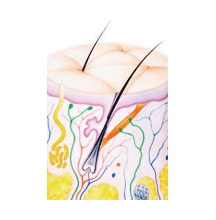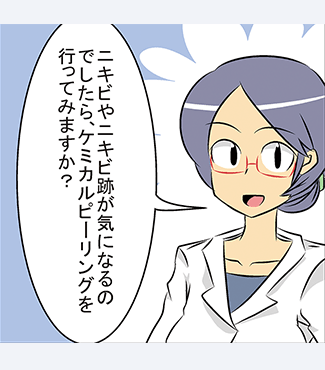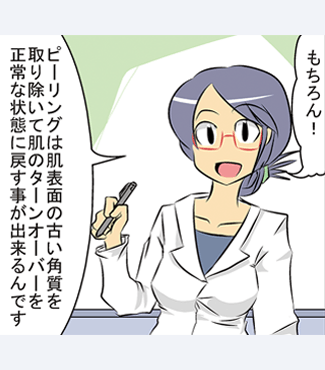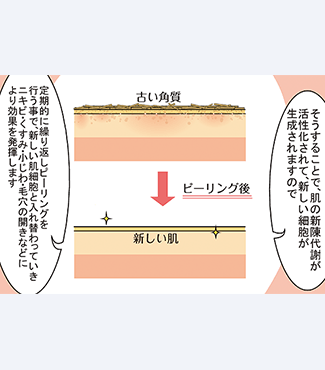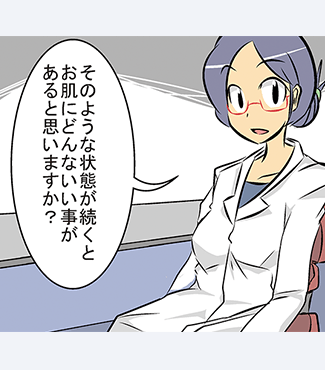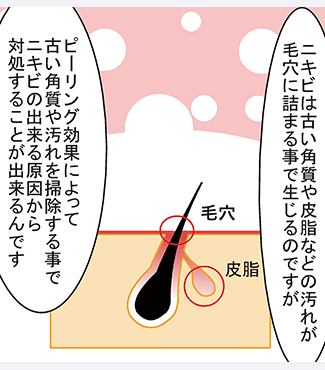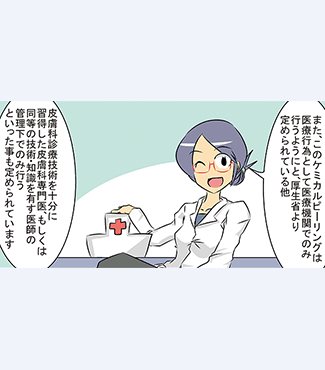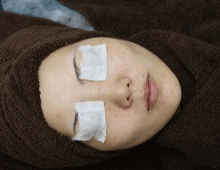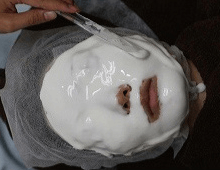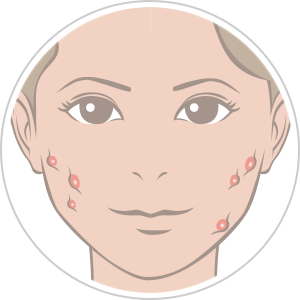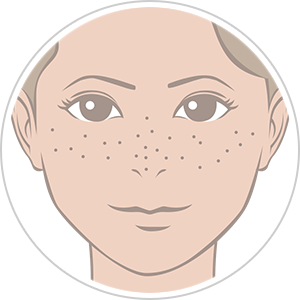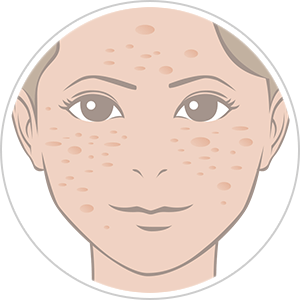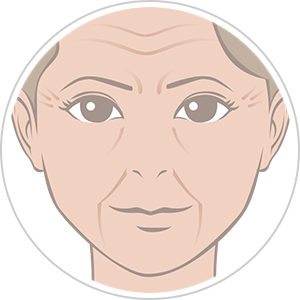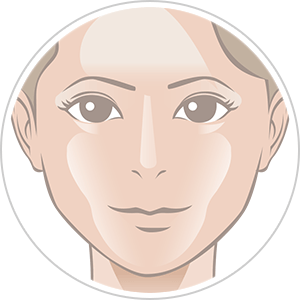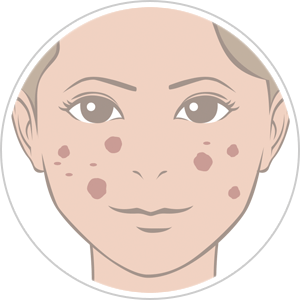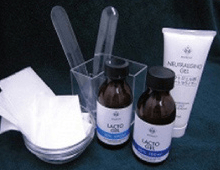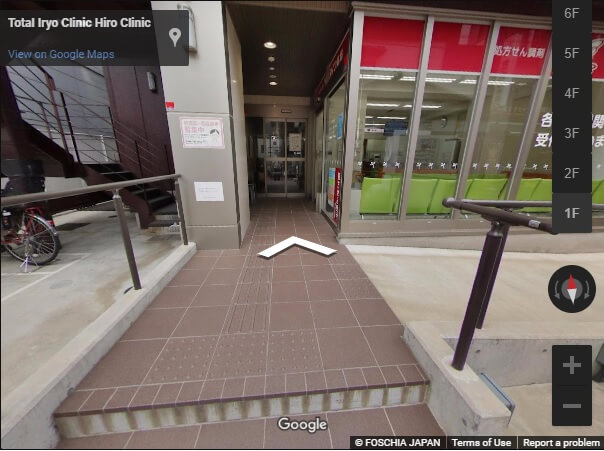Chemical Peeling Treatment
Chemical peeling is a treatment that uses chemicals such as glycolic acid to remove dead skin cells and outer layers.
The removal of the dead skin layer improves the appearance of clogged pores and promotes the regeneration of new skin.
This is a treatment that aims to restore healthy and beautiful skin.
Although the term “skin peeling” may sound frightening, there are no scary side effects such as pain or bleeding because the procedure involves peeling off the outer layer of the skin, either the stratum corneum or a part of the epidermis where there are no blood vessels.
Medications used in our clinic
- AHA (glycolic acid): For Acne, Acne scars
- Lactic acid: blemishes, dullness, whitening, anti-aging
The appropriate formulation and is determined by the purpose of treatment and skin type. At our clinic, we do not use our own formulations, but select formulations that have been adjusted to the optimum pH and other parameters from a cosmetic point of view. It is also less irritating and can be used safely by those who have experienced peeling before but could not continue because of the irritation.
Only here at Hiro Clinic
-
The most suitable peeling agent and concentration will be adjusted to meet your needs.
-
We also provide advice on appointment schedules for better results, as well as the use of iontophoresis.
-
We can also adjust the application method and increase the concentration to see the effect during the treatment.
Hiro Clinic Web Comic
Chemical peeling
Skin Turnover
The periodic renewal of old cells on the surface of the skin is called turnover. The skin is composed of epidermis, dermis, and subcutaneous tissue. The epidermis, the outermost thin layer, consists of the stratum corneum, stratum granulosum, stratum spinosum, and stratum basale. It is said that it takes about 14 days for the cells produced in the basal layer to reach the surface of the skin and about 14 days for them to exfoliate on the surface and fall off.
In other words, in a normal skin turnover, new epidermal cells are replaced about every 28 days. If the turnover does not go well and excess dead skin cells pile up, it not only clogs the sebaceous glands and causes clogged pores and acne but also slows down the reaction of sunburn and blemish pigments to rise to the surface and peel off.
By enabling normal turnover, acne can be prevented, sebum production can be normalized, and the healing process of dark spots and dullness can be smoothed out.
The flow of Chemical Peeling Treatment
-

Skin Counseling
This is a consultation with a doctor. The doctor will assess the condition of each person’s skin and propose the most effective peeling plan.
-

Cleansing and degreasing
Cleanser and facial cleanser are included.
-

Chemical Peeling Treatment
We adjust the concentration of the peeling agent chosen according to the condition of your skin and apply it for the appropriate amount of time.
-

Wiping off and rinsing of face
After looking at the condition of your skin, we will neutralize the peeling agent and wipe it off.
-

Iontophoresis (upon request)
After chemical peeling, the skin is reset and the active ingredients can be absorbed easily.
We offer various types of iontophoresis and electroporation, such as vitamin C for acne improvement and whitening, tranexamic acid for melasma, glycylglycine for pores, and placenta, skin regeneration factors, and hyaluronic acid for those seeking beautiful skin and anti-aging care. -

Calm pack
A soothing and moisturizing pack to soothe sensitive skin. The pack is also effective in helping the active ingredients to penetrate and settle into the skin.
Effects of Chemical Peeling
The skin’s cells are renewed in a 28-day cycle (turnover). (When this cycle is affected by ultraviolet rays, stress, and aging, various problems such as acne, and dullness, fine lines, and wrinkles will occur. Chemical peeling removes dead skin cells from the surface of the skin and dirt from the pores, making the skin turnover smoother.
When old dead skin cells and dirt in the pores are removed by chemical peeling, the skin activates its metabolism and produces more and more new cells to be reborn as new skin.
By stimulating metabolism and the production of new cells, it improves the skin environment and solves various problems such as acne, dullness, and fine lines and wrinkles.
What can be achieved by Chemical Peeling
- Acne and Acne scars
Improves acne by eliminating pore clogging and normalizing sebum secretion. It also reduces the appearance of acne scars by smoothing out bumps.

- Opening of pores
By eliminating pore clogging and normalizing sebum secretion, pores will become less visible.

- Dull skin
The excess dead skin cells are removed, and the skin’s turnover is normalized, thereby eliminating dullness.

- Wrinkles
The surface of your skin will become smoother and the skin will be reborn, making your skin look younger and healthier, which will also improve fine lines and wrinkles.

- Oily or Dry skin
Sebum secretion is normalized and skin metabolism is normalized, thus improving the condition.

- Spots and freckles
This treatment stimulates the pigment in the skin to rise to the surface and peel off as the skin is reborn. It can be used in combination with light therapy to make the spots fade faster.

When the skin has been exfoliated and thinned, the iontophoretic application of vitamin C is effective in promoting the subsiding of acne and further increasing the whitening and beautifying effects of the skin due to the collagen-producing, melanin-inhibiting, sebum-controlling, and anti-aging effects of vitamin C. For those suffering from melasma, tranexamic acid iontophoresis is also available.
Difference between chemical peeling and other peelings
Weak peels done in salons or home care can give a temporary smooth feeling, but it does not improve the quality of the skin. This is because peeling needs to be done at a certain intensity in order to improve skin texture.
However, forcing a strong peel may cause damage to the skin surface and pigmentation. The Ministry of Health and Welfare has informed that chemical peels should only be performed at medical institutions as a medical treatment.
In addition, the guideline states that “the procedure should be performed under the supervision of a dermatologist or a physician with equivalent skills and knowledge who is fully trained in dermatological techniques. It is recommended that you receive treatment at a specialized medical institution.
Types of Chemical Peels
Glycolic acid peeling
This is the most commonly used formulation of chemical peels. It is often used to treat acne, but it is also used to treat blemishes and to beautify the skin because of its ability to stimulate the skin’s renewal process.
We use different concentrations in different stages, usually starting with a weaker concentration and adjusting the concentration according to the purpose and the condition of the skin.
We do not use self-made formulations, but rather formulations that are easy on the skin with an appropriately adjusted pH level, so they are less irritating and can be used safely by people who have never been able to continue using them due to irritation.
This treatment is appropriate for acne because it penetrates the skin well and is highly effective in exfoliating the unwanted dead skin cells that cause acne.
You may experience a tingling sensation.
It is recommended that the treatment cycle be repeated approximately every three weeks.
After the skin has been exfoliated and cleaned, the iontophoretic application of vitamin C is effective in calming acne and increasing the whitening and beautifying effects of the skin due to its collagen-producing, melanin suppressing, sebum controlling, and anti-aging effects. For those suffering from melasma, tranexamic acid iontophoresis is also available.
Lactic Acid peeling
Lactic acid has a high molecular mass and is considered to be a skin-friendly acid.
Lactic acid itself has a whitening effect, so it is recommended as a treatment for blemishes.
We do not suggest Chemical Peeling to:
- Those who have damage from shaving, masks or sloughing their face the day before.
- Those who have had laser treatment or waxing just before the treatment.
- Those who have skin infections such as herpes or Ritter’s disease.
- Those who got a heavy sunburn just before the treatment.
- Those who are pregnant or breastfeeding
If you have any questions, please feel free to contact us.
Peeling Procedure Video
Price of Chemical Peeling Treatment
※Free medical treatment, not covered by insurance.
| Treatment Name | Rates (excluding tax) | |||
| First session | Second session & above | 6 sessions (set) | ||
| Glycolic acid peeling student discount (standard with skin care) | - | 8,000 yen | 36,000 yen | |
|---|---|---|---|---|
| Glycolic acid peeling | With standard skin care | 5,000 yen | 8,000 yen | 45,500 yen |
| With sedation pack | - | 10,000 yen | 53,000 yen | |
| Lactic acid peeling | With standard skin care | 5,000 yen | 8,000 yen | 45,500 yen |
| With sedation pack | - | 10,000 yen | 53,000 yen | |
| Chemical peeling + carbon peeling (whole face) | - | 29,000 yen | 155,000 yen | |
| Chemical peeling + carbon peeling (whole face) + Genesis | 20,000 yen | 48,000 yen | 250,000 yen | |
Frequently Asked Questions (About Cosmetology)


When this turnover cycle is disrupted by UV rays, stress, aging, and other factors, various problems such as acne, dullness, fine lines, and dryness can occur. Chemical peeling removes the dead skin cells on the surface of the skin and returns the skin turnover to normal.








